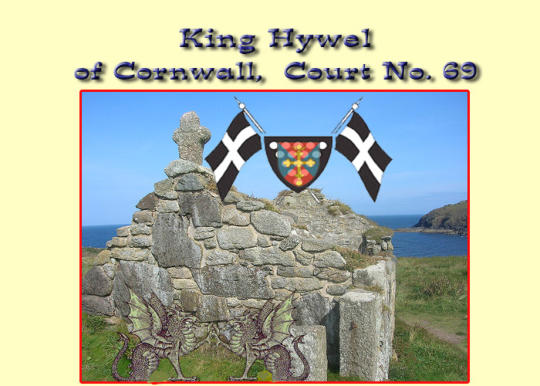



© 2021 Provincial Grand Court of Wessex

King Hywel of Cornwall No.69: Meeting at :
The Masonic Hall, Liskey Hill, Perranporth, Cornwall. TR6 0HR
Regular meetings of the Court are held on the 4th. Monday in
January, November and second Monday in June (Installation)
CONTACT SECRETARY: W.Bro. Clive T. Major
e-mail: forge2009@hotmail.co.uk
Address: Arcadie, Roseland Parc, Rosewarne
Camborne, Cornwall. TR14 8NB
Phone: 01209 71 1631
ORATION : KING HYWEL of CORNWALL COURT No. 69, 25th. September 2010
by W.& Em.Bro. George E.R. Gardner, Provincial Eminent Grand Prior of Wessex
King Hywel of Cornwall No.69
A short enlightenment to the period of time within Wessex
The complete supremacy of the House of Wessex was firmly established under Athelstan and could correctly be described as
the first true King of all England. Athelstan used the title Basillius, The Greek term for King.
Much of his reign was occupied, as were his forefather`s, with the ongoing struggle with the Viking invaders. Athelstan
concluded a treaty with them at Tamworth, by the terms of which he married his sister, Edith, to the Danish leader Sithric, King
of York. Sithric died the following year and Athelstan seized the opportunity to take Northumbria. His kingdom thereby
became roughly equivalent in size to modern England.
There is no record of him taking his campaigns into Cornwall. It seems probable that Hywel, King of the Cornish, agreed to pay
tribute to Athelstan, as he did to Alfred the Great, and thus avoided more attacks and maintained a high degree of autonomy.
The Celtic Prince of Wales paid homage to him at Bamburgh in the early part of his reign along with Hywel, King of Cornwall,
Constantine 11, King of Scots and Owen of Gwent. Athelstan succeeded in expelling the Cornish from Exeter and established
his border with Cornwall as the river Tamar. The boundary between Anglo-Saxon Wessex and Celtic Cornwall.
King Athelstan set up a bishopric at St. Germans. It lasts until 1042 when the sea is united with Crediton and is later removed
to Exeter, after which Cornwall remains an archdeaconry until 1876.
The church of St. Germanus is finally consecrated in 1261 after its re-organisation by Bishop Bartholomew and was an
Augustinian priory (1161-84). Eight centuries on St. Germans displays more of Norman planning than any other Cornish
church, Although two thirds of them have some Norman traces..






© 2021 Provincial Grand Court of Wessex

King Hywel of Cornwall No.69: Meeting at :
The Masonic Hall, Liskey Hill, Perranporth, Cornwall. TR6 0HR
Regular meetings of the Court are held on the 4th. Monday in
January, November and second Monday in June (Installation)
CONTACT SECRETARY: W.Bro. Clive T. Major
e-mail: forge2009@hotmail.co.uk
Address: Arcadie, 111 Roseland Parc, Rosewarn,
Camborne, Cornwall. TR14 8NB
Phone: 01209 71 1631
ORATION : KING HYWEL of CORNWALL COURT No. 69, 25th. September 2010
by W.& Em.Bro. George E.R. Gardner, Provincial Eminent Grand Prior of Wessex
King Hywel of Cornwall
A short enlightenment to the period of time within Wessex
The complete supremacy of the House of Wessex was firmly established under Athelstan and could correctly be described as
the first true King of all England. Athelstan used the title Basillius, The Greek term for King.
Much of his reign was occupied, as were his forefather`s, with the ongoing struggle with the Viking invaders. Athelstan
concluded a treaty with them at Tamworth, by the terms of which he married his sister, Edith, to the Danish leader Sithric, King
of York. Sithric died the following year and Athelstan seized the opportunity to take Northumbria. His kingdom thereby
became roughly equivalent in size to modern England.
There is no record of him taking his campaigns into Cornwall. It seems probable that Hywel, King of the Cornish, agreed to pay
tribute to Athelstan, as he did to Alfred the Great, and thus avoided more attacks and maintained a high degree of autonomy.
The Celtic Prince of Wales paid homage to him at Bamburgh in the early part of his reign along with Hywel, King of Cornwall,
Constantine 11, King of Scots and Owen of Gwent. Athelstan succeeded in expelling the Cornish from Exeter and established
his border with Cornwall as the river Tamar. The boundary between Anglo-Saxon Wessex and Celtic Cornwall.
King Athelstan set up a bishopric at St. Germans. It lasts until 1042 when the sea is united with Crediton and is later removed
to Exeter, after which Cornwall remains an archdeaconry until 1876.
The church of St. Germanus is finally consecrated in 1261 after its re-organisation by Bishop Bartholomew and was an
Augustinian priory (1161-84). Eight centuries on St. Germans displays more of Norman planning than any other Cornish
church, Although two thirds of them have some Norman traces..





























